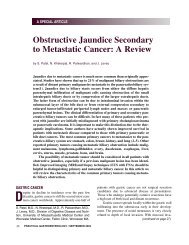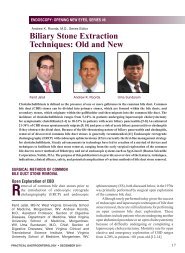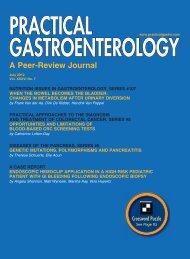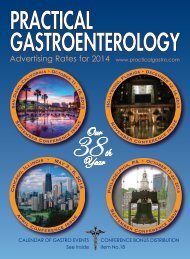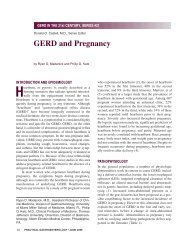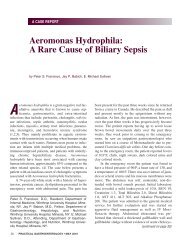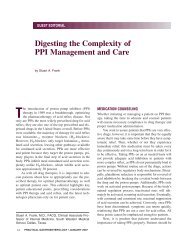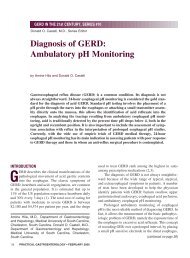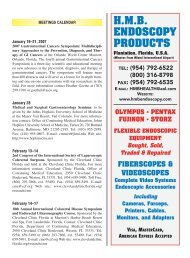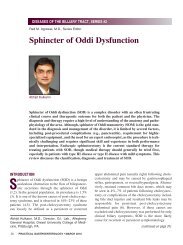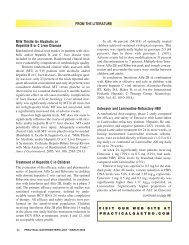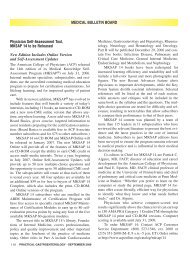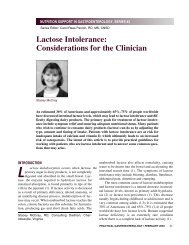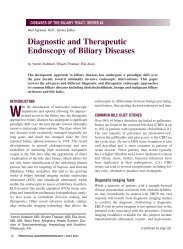Eosinophilic Esophagitis - Practical Gastroenterology
Eosinophilic Esophagitis - Practical Gastroenterology
Eosinophilic Esophagitis - Practical Gastroenterology
Create successful ePaper yourself
Turn your PDF publications into a flip-book with our unique Google optimized e-Paper software.
<strong>Eosinophilic</strong> <strong>Esophagitis</strong><br />
GERD IN THE 21ST CENTURY, SERIES #14<br />
ology could allude to a predisposing factor as the etiology<br />
of EE is still unknown.<br />
Since eosinophils are not natural residents of the<br />
esophageal mucosa, many hypotheses for the recruitment<br />
of eosinophils to the esophagus have been investigated.<br />
One hypothesis is that EE may be a delayed<br />
hypersensitivity reaction to food allergens. In 1995,<br />
Kelly, et al proposed that EE developed as a response<br />
to dietary protein(8). They conducted a study of 10<br />
pediatric patients with symptoms attributed to GERD<br />
refractory to antisecretory medications. These patients<br />
were found to have eosinophilic infiltration limited to<br />
the esophagus ( no evidence of eosinophilic gastroenteritis).<br />
The patients completed 6 weeks of a diet with<br />
an elemental formula (consisting of free amino-acids,<br />
median chain triglyceride oil and corn syrup) as well<br />
as clear liquids. Older patients were allowed to have<br />
corn and apples as these foods have been found to have<br />
extremely low likelihood of inducing a hypersensitivity<br />
reaction. After the 6 weeks, patients underwent<br />
repeat endoscopy and biopsy. Eight out of 10 patients<br />
had a resolution of their symptoms and 2 had marked<br />
improvement. All patients had a reduction in the number<br />
of eosinophils on their repeat biopsies and five of<br />
10 patients had none. Eight of 10 patients were able to<br />
stop their antireflux medications. Markowitz, et al (9)<br />
in a larger study found similar findings. In their study,<br />
51 patients who had symptoms refractory to medications<br />
and had negative tests for reflux disease had<br />
improvement in their symptoms and biopsies after one<br />
month of an elemental diet (9).<br />
Another interesting hypothesis is that EE is an<br />
immunologic response to allergens outside of the gastrointestinal<br />
tract, in particular the respiratory system.<br />
It is thought that there may be a connection between<br />
the T helper cell immune response in the lung and in<br />
the esophagus. T helper cells secrete cytokines such as<br />
IL-5, the most potent and specific activator of<br />
eosinophil activation and recruitment. Other important<br />
cytokines include IL-4 and IL-13 which are found in<br />
elevated levels in the asthmatic lung. Dysregulation of<br />
IL-13 has been reported in asthma, atopic dermatitis,<br />
and allergic rhinitis. Mishra, et al proposed that the<br />
overexpression of IL-13 in the lung may contribute to<br />
the development of EE (10). They conducted a study<br />
in IL-5 deficient mice as well as wild type mice, in<br />
which IL-13, IL-4, IL-9, IL-10 or saline were delivered<br />
intratracheally. The esophagus and bronchoalveolar<br />
lavage (BAL) fluid were examined. When<br />
doses of 1.0 and 10 µg of IL-13 were delivered, there<br />
was a significant increase in the number of eosinophils<br />
detected in the esophagus and the BAL fluid but not<br />
in the stomach of these mice. None of the other<br />
cytokines produced the same effect. Also, EE did not<br />
develop in IL-5 deficient mice demonstrating that<br />
IL-5 is crucial in priming and activating eosinophils<br />
after IL-13 delivery.<br />
HISTORY<br />
Symptoms can range from nausea, vomiting, abdominal<br />
pain, heartburn, chest pain, globus sensation, or<br />
regurgitation to dysphagia to solids leading to food<br />
impaction. In children, the symptoms may be more<br />
subtle such as poor growth, abdominal pain, irritability,<br />
nighttime cough, slower rate of eating, or even a<br />
lack of interest in eating. The classic historical feature<br />
in an older child or adolescent is that they have learned<br />
to eat so slowly and chew their food so well that they<br />
are always the last member of the family to leave the<br />
table after a meal.<br />
There is a male predominance among adult patients.<br />
Pediatric patients have a stronger association with<br />
atopic disease with a personal or family history of seasonal<br />
allergies, eczema, rhinitis, conjunctivitis, dermatitis,<br />
or asthma. In 2001, the Cincinnati Childrens Hospital<br />
Medical Center launched a world-wide-web based<br />
registry (www.cincinnatichildrens.org/eosinophils) for<br />
eosinophilic gastrointestinal disorders and in 4 months,<br />
107 surveys were completed by patients through the<br />
website (11). Of these, 51 patients identified themselves<br />
as having eosinophilic esophagitis. Sixty-four percent<br />
reported a history of allergic conjunctivitis, 38% with<br />
asthma, and 26% with eczema. However, the history of<br />
atopy is not necessary to make the diagnosis.<br />
PHYSICAL EXAM<br />
There are no distinctive physical findings in patients<br />
with EE that distinguishes EE from other diseases.<br />
(continued on page 47)<br />
42<br />
PRACTICAL GASTROENTEROLOGY • SEPTEMBER 2005



